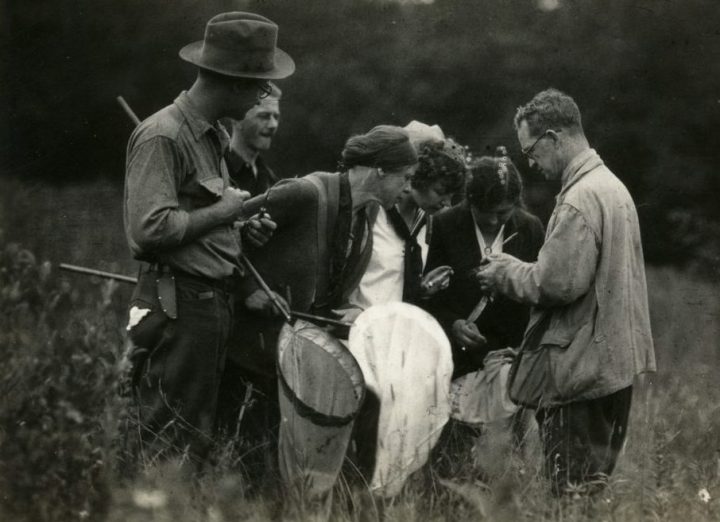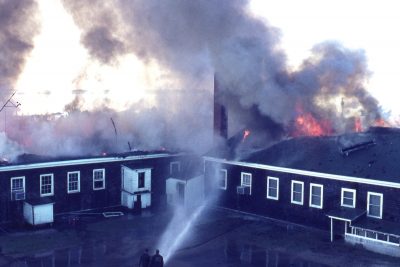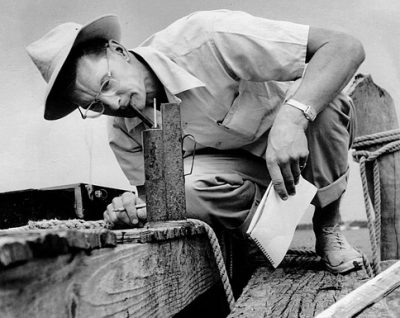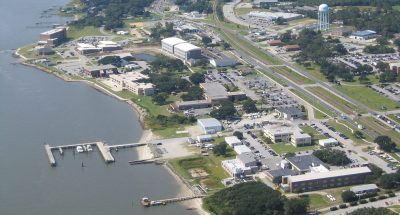
MOREHEAD CITY – Shrimp. Oysters. Sharks. Estuaries. Stormwater.
These are only a handful of the topics explored by researchers, graduate and undergraduate students at the University of North Carolina’s Institute of Marine Sciences, which marks its 70th anniversary this year. The 60,000-square-foot facility just off U.S. 70 and on the shore of Bogue Sound hosts the research of a dozen faculty members as well as upwards of 25 resident graduate students.
Supporter Spotlight
Early Beginnings
The earliest rumblings of what would become the institute began in 1894, when a UNC professor in the Biology Department, Dr. Henry Van Peters “Froggie” Wilson, began bringing students to Pivers Island in Beaufort to take summer courses in marine zoology, intent on giving them hands-on educational experiences. In the following years, interest began to grow in fisheries research and its potential economic benefits.

By 1945, another UNC biology professor, Dr. Robert E. Coker, put together a report, with encouragement from state officials and university leaders, outlining the value of marine sciences as an economic resource. This assessment led to the proposal for a coastal marine research institute.
The original campus opened in Morehead City in 1947 in World War I-era naval facilities that were once used by Camp Glenn, which had also previously served as a National Guard camp and in the 1920s as the first Coast Guard air station.

The institute’s researchers lived then, and continue to live, in the area. At the time, the institute went by a different name: Institute of Fisheries Research, which reflected work taking place here. The campus was renamed the Institute of Marine Sciences in 1967 as the institute’s research began to broaden.
Supporter Spotlight
The first student to ever take residence at the facility was in 1964, and she happened to be a woman, Deborah Dexter, who earned her doctorate in zoology in 1962 and continued her research at the institute until 1967. After graduating from UNC, Dexter spent the rest of her career at San Diego State University, where she retired in 2001.
Modern Evolution

Although the institute’s current name dates back only 50 years, Dr. Michael Piehler, a professor at the institute, said the year 1947 was chosen as the institute’s start date because the Institute of Fisheries Research is the original organization from which institute was born.
Current Institute of Marine Sciences Director, Dr. Rick Luettich said that the institute’s evolution has been remarkable.
“(The institute is a) culmination of something that was really focused on student education and classes and summertime kind of things,” he said, “to something that was permanent, really focused on the research enterprise and that applied research and practical research that was helping enable the local population better utilize the resources that were here.”
Initial work at the institute, when it was still called the Institute of Fisheries Research, focused heavily on fish surveys and ways to help the local fishing economy thrive.

Piehler said that the institute’s first major study found that shrimping at night leads to more brown shrimp yields. This put the institute on the map.
“That is regarded as the first major finding of UNC marine science research that had big impacts on the economy of the coast,” he said. “That study at that time with the scientists living here and working here really set the tone for what the institute was to become.”
Since then, the institute has released other major findings and collections that have contributed to the understanding of the state’s coast and international marine science.
Dr. Frank Schwartz, a professor at the institute, has been running the country’s longest-running shark survey for 45 years. Every two weeks during the spring, summer and fall, students and professors tag sharks and collect detailed data.
Luettich said that while other shark data exist, Dr. Schwartz’s long-term research has allowed scientists to observe the precipitous decline of shark species over time.
“There are a few datasets that can demonstrate how that part of the food chain has been impacted,” he said.
Oysters, Luettich said, have also been a major area of research at the institute. Almost every faculty member has worked with oysters in some way or another, including prominent findings by Dr. Pete Peterson.
Other notable research includes findings on worldwide algal blooms by Dr. Hans Paerl, coastal flooding by Luettich and pathogen indicators in shellfish and recreational waters by Dr. Rachel Noble.
The institute has provided three major natural history collections: the Kohlmeyer Marine Fungi collection, which is now housed in the New York Botanical Garden, a collection of fish species collected by Schwartz, which is housed in the North Carolina Museum of Natural History, and a mollusk collection by Dr. Hugh Porter, which is at the same museum. These collections serve as important references for other researchers.
While the institute has generally avoided controversy, its science has been contributed to difficult conversations, including sea level rise and sharks.
“Our critical role is to be objective, rigorous and try to bring our science, that objectivity at least, to the issues,” Luettich said.

The Fire of 1968
An interesting chapter in IMS’s history is a fire that expedited a move to the institute’s current facility.
Up until 1968, IMS was housed in a 7,700-square-foot wooden naval property that formerly served as a dispensary for Camp Glenn. However, a fire burned through the facility on the morning of Nov. 21 of that year, a Thursday. While no one was injured, the institute lost equipment and a dormitory in the blaze. According to a report in the Carteret County News-Times, most of the institute’s equipment had already been moved to a new facility, the current building just east of the original site. There was “significant” damage to what remained.
Among the destroyed items included two large experimental tanks, a supply of scientific glassware and between $15,000 and $20,000 worth of equipment belonging to the Shellfish Sanitation Division of the State Department of Health. Associate professor Dr. W.E. Fahy, who used the experimental tanks, said he estimated the total loss of his materials at $14,500. Adjusted for inflation, the damage would total about $239,000 today.

There was an effort to protect some of the valuable records that remained. Staff of the institute ran in and out of the building as the fire burned to salvage records from the office of Dr. A.F. Chestnut, the institute’s director at the time. Almost all the records were saved, enough to fill a pickup truck.
The institute’s library had been moved the day before the fire, according to the News-Times, and maps of North Carolina’s first-ever oyster study were removed from the burning building with moments to spare.
The cause of the fire was never officially determined, but the blaze started in the furnace room, according the fire marshal, and smoldered for two or three hours before it was discovered. Also, the building’s wiring was described as “old” and “bad” in a report from the News-Times.
Looking Ahead
Luettich said the institute is fortunate to receive strong support from UNC, which is integral to the institute’s success. He said the institute was also fortunate to have the ability to collaborate with other labs in the Morehead City-Beaufort area. The combination of all these facilities is sometimes termed “RTP East.”

Pivers Island in Beaufort houses both Duke University’s Marine Lab and a National Oceanic and Atmospheric Administration’s fisheries lab. North Carolina State University also has a lab in Morehead City, known as CMAST, or the Center for Marine Sciences and Technology.
Luettich said he’s excited for the work the institute has going on now.
“We are fortunate that our faculty (is) really productive and do a huge amount of externally funded research, which keeps this place really vital,” he said, adding that the institute’s research keeps a constant flow of graduate students in and out of the door, with fresh and exciting ideas coming with them.
“One of the great parts of our history is that we’re still here and hopefully doing great stuff,” he said.







